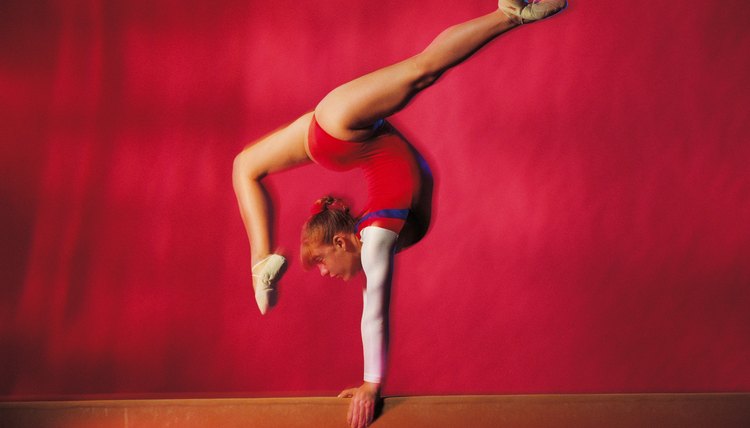The Training That It Takes to Be a Gymnast

The sport of gymnastics demands great flexibility, agility and strength. The skills typically require many years to master. To reach the upper echelon of men's and women's gymnastics -- regional, collegiate, national and international competition -- athletes must train year-round. Gymnasts starting the sport at a young age often develop the necessary athletic abilities by practicing the skills. Gymnasts coming to the sport at later ages may need to condition their bodies to participate in the sport. In men's gymnastics, upper body and core muscle strength is especially critical in the pommel horse and rings events.
Early Gymnastics Training
Gymnasts, especially girls, tend to start gymnastics at a young age. Beginner classes for preschool age children feature tumbling on mats and trampolines. Entry-level classes teach fundamental moves such as the forward roll, backward roll, cartwheel, handstand, bridge and back bend. Such instruction teaches "air awareness, to know where their body is, what it is doing at all times," says Jami Sharp, competitive program director for Black Diamond Gymnastics and Sports Center in South Jordan, Utah, in her iSport instructional video.
Advancing in the Sport
After gymnasts master the basic movements and gain flexibility, they begin training on apparatus such as the balance beam and the bars. Youngsters tend to make the transition more easily. “Very difficult gymnastics skills are more easily learned and much better learned at a younger age, say 8 to 11 years of age,” coach John Howard wrote on his website, GymnasticsZone.com. “Younger gymnasts also do not usually have any fear of doing gymnastics skills and they adapt to hard training regimens more easily.” Gymnasts moving up to higher competitive levels face increasingly rigorous training workloads, perhaps augmented by resistance training.
The Demands of Competitive Gymnastics
Competitive gymnasts may practice and/or compete several times a week. Elite gymnasts make the sport their life. In a publication for pediatricians and parents, the American Academy of Pediatrics warned that "long hours, year-round participation, frequent competition, pressure to increase skills, parents’ financial commitment and social isolation can lead to over training, 'burnout' and depression at a young age."
Gymnastics and Physical Maturity
As male gymnasts mature physically, they can add the muscular strength needed to master the more demanding skills such as the rings and pommel horse. As female gymnasts mature, they may gain weight that limits their ability to perform high-flying acrobatics. They tend to peak competitively at a much younger age. Female gymnasts also face medical risks, as the American Academy of Pediatrics warns: "Due to the emphasis on thinness, eating disorders such as anorexia and bulimia are common yet often ignored or unrecognized. Female Athlete Triad, the combination of disordered eating, menstrual dysfunction and osteoporosis, is more common in gymnastics than other sports."
The Physical Toll of Gymnastics
Proper training is necessary to limit injury, because gymnastics can take a tremendous toll on the body. Wrist, elbow, shoulder, lower back, knee, ankle and foot injuries are common among competitive gymnasts. Gymnasts should advance at a sensible rate, avoid over-training and work under expert supervision.
References
Writer Bio
Jeff Gordon has been reporting and writing since 1977. His most recent work has appeared on websites such as eHow, GolfLink, Ask Men, Open Sports, Fox Sports and MSN. He has previously written for publications such as "The Sporting News" and "The Hockey News." He graduated from the University of Missouri-Columbia School of Journalism in 1979 with a bachelor's degree.
